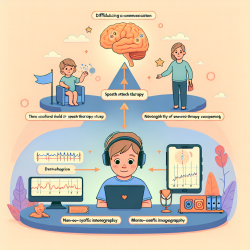Understanding Delayed M50/M100 Responses in Autism
In the realm of speech-language pathology, understanding the neurophysiological underpinnings of language impairments in children with autism spectrum disorder (ASD) is crucial. A recent study titled Delayed M50/M100 evoked response component latency in minimally verbal/nonverbal children who have autism spectrum disorder sheds light on the delayed auditory processing observed in minimally verbal/nonverbal (MVNV) children with ASD.
Key Findings from the Study
The study utilized magnetoencephalography (MEG) to measure M50 and M100 responses in the superior temporal gyri of three groups: MVNV children with ASD, verbal children with ASD, and typically developing children. The findings revealed that MVNV children exhibited significantly delayed M50 and M100 latencies compared to their peers. These delays were associated with language and communication skills, as assessed by the Vineland Adaptive Behavior Scale Communication Domain.
Implications for Practitioners
These findings offer valuable insights for practitioners aiming to improve outcomes for children with ASD. Here are some actionable steps:
- Integrate Neurophysiological Assessments: Consider incorporating MEG or similar neuroimaging techniques into your diagnostic toolkit to better understand the auditory processing capabilities of children with ASD.
- Focus on Communication Skills: Use the Vineland Adaptive Behavior Scale to assess communication skills and tailor interventions that target these specific areas.
- Develop Customized Therapy Plans: Recognize the variability in auditory processing delays among children with ASD and customize therapy plans to address individual needs.
Encouraging Further Research
The study highlights the need for further research into the neurophysiological mechanisms underlying auditory processing in MVNV children with ASD. Practitioners are encouraged to collaborate with researchers to explore innovative approaches and interventions that can enhance language outcomes for these children.
Conclusion
By understanding the delayed M50/M100 responses in MVNV children with ASD, practitioners can make data-driven decisions to improve language and communication outcomes. This research underscores the importance of integrating neurophysiological insights into therapeutic practices.
To read the original research paper, please follow this link: Delayed M50/M100 evoked response component latency in minimally verbal/nonverbal children who have autism spectrum disorder.










